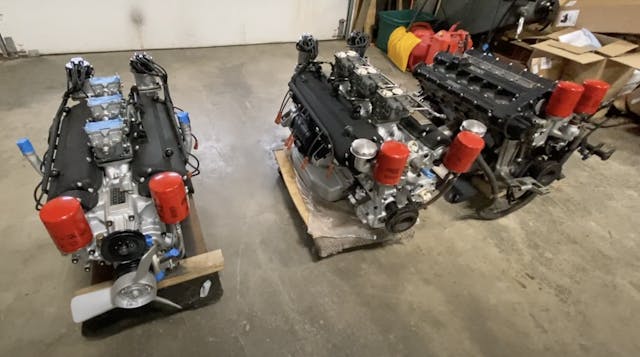Take a look inside the world of vintage Ferrari V-12 engines
The vintage Ferrari world is one of of minutia and secret code. Three numbers and two letters comprise a model name, and once you know their meanings you can decipher the engine and body style from those five digits. The classic V-12s are worshipped for their beauty in both looks and exhaust note, but what are they really like when you dig a bit deeper and compare them to one another? Luckily, Ferrari restorer Tom Yang gave us all an inside look.
At first glance it seems a bit crazy that these three different engines just so happened to be out of their respective cars, but Yang is a Ferrari restorer, and while shuffling projects he realized it was a perfect chance to visually represent Ferrari V-12 history.
The vaunted 250 GTO sits on a very high pedestal even in the world of Ferraris, but it basically shares it engine with the rest of the 250-series cars built in the same era. As Yang tells us, the architecture is the same across the lineup. Of course, there are larger head studs and a few other small changes, but the bottom end is basically the same. If you think that means servicing one would be easier, you would be wrong.
Each of the three engines in question received updates throughout their short production runs, which means the best way to identify the proper part is to take apart what is there and measure. Water pumps in particular are a pain, because the design changed multiple times for each engine. Getting the correct gasket, bearing, or replacement part is a matter of millimeters, and some parts houses are better than others at knowing the essential details that will get you the correct part the first time.
This phenomenon isn’t unique to Ferrari engines, but it is extra tough with Maranello’s motors for a specific reason: The engines are serialized and built separately from the chassis. There are two stampings on the back of most Ferrari V-12s, one that allows the factory to track the engine and how it was built, and another that designates the chassis number in which it was installed. Factory documentation provides an extra layer of protection against an unauthorized effort to produce a numbers-matching car from a mismatched engine and chassis. A person trying to pull something like this would need both the correct serial number and chassis number. If you contact Ferrari, someone will tell you when you’re wrong but won’t dish the correct information. Think of it like when paying a company over the phone with a credit card; they won’t tell you the credit card number on file, but they will confirm it if you tell them one that matches.
My main question after watching this breakdown: Which of these engines is the easiest to work on? They all seem pretty tough, but Yang has his preferences. “The early Colombo two-cam engines are certainly easier to work on, but of course compared to a small-block Chevy or something even it is a real pain. Just pulling the valve covers is a multi-hour job. However, even with that I still enjoy working on those engines.”
I’ll leave that work to Yang, but getting to see the intricacies of these vintage Ferrari masterpieces is a treat. It’s really awesome to see these engines out of cars and talked about in a language that just about every enthusiast can understand, while also giving an insight to why documentation and provenance can mean so much for V-12 era Ferraris. Not that I am shopping, or anything.


